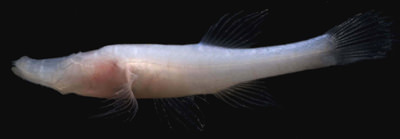Alabama Cavefish

Critically endangered
The Alabama cave fish is an eyeless fish without any natural pigment and almost completely translucent fins. Both juvenile and adult cave fish have long flattened snouts and mouth pieces that resemble a duck's bill, and the head of the Alabama cavefish makes up roughly one third of its entire body. The Alabama cavefish is also equipped with what look like spiked fins and typically grows to between 30-58 millimeters in length. Classed as the most specialized cavefish currently known about, only 9 have ever been directly observed and it is estimated that fewer than 100 Alabama cavefish currently exist in the wild.
Because of the dark environment in which the Alabama cavefish resides, it has a complex arrangement of sensory nipple like clusters of cells arranged on its head and sides. It is also believed that the Alabama cavefish incubates its young in its mouth and that this is perhaps the reason for its distinct head size and mouth piece design. However, the Alabama cave fish has a complex reproductive cycle. Rather than reproducing once a year, the Alabama cave fish appears to only reproduce when the cave in which it can be found floods seasonally and triggers a hormonal response.
As for diet, the Alabama cavefish subsists mainly on a diet of bat guano and small cave dwelling organisms like mites and small beetles.
Population Distribution
At present the Alabama cavefish is known only to inhabit a single cave system called Key Cave in Lauderdale County Alabama. There have been reports of Alabama cavefish sightings in a nearby cave, however, these are as yet unconfirmed. Believed to number just 100 in total it has been hoped since the discovery of Alabama cavefish that periodic flooding might help disperse the species to other cave systems. Key Cave seems however, to support a unique and fragile ecosystem. Fed by the Tennessee River watershed, Key cave itself is a maze like complex with very little year round flow. Pools in which the Alamaba cavefish can be found can reach depths of five meters and the overall ecosystem of Key cave appears to depend on at least two pools where bat guano deposits routinely slide into the water.
Threats
Because of the Alabama cavefish being restricted to just a single and apparently unique cave system, the most significant threat to the species' survival is represented by any change to its habitat. Declining roosting bat numbers pose one such threat to the species as this directly effects the amount of bat guano which the Alabama cavefish depends on for survival. Also, some observers have noted that whilst the Alabama cavefish is unable to disperse to other locations, it may actually have to compete for resources with more common southern cavefish. However, the most significant threat to the continued existence of the Alabama cave fish comes from the very water which it lives in. Changes in seasonal weather and flooding patterns threaten to interrupt the Alabama cavefishes' reproductive cycle. Likewise, changes in ground water quality pose a significant threat to the species in regard to pollution and chemical contamination.